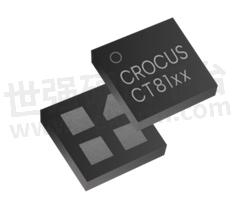Crocus’ XtremeSense® TMR CT81xx Sensors: a Combination of High Sensitivity, Low Power and Small Footprint for Medical Wearables Applications

Sensors with the ability to measure magnetic fields are fast gaining traction in remote patient- monitoring applications. Hermetically sealed, battery- powered wearable medical applications are becoming increasingly common as technology quickly advances.
The seal prevents the entry of moisture and other contaminants, critical for medical devices implanted in the body or in contact with bodily fluids. Moisture and contaminants can cause failure in a wide variety of these devices, including pacemakers, defibrillators, insulin pumps, glucose monitors, electrocardiogram (EKG) monitors, and even contact lenses.
The functionality of medical wearables requires a combination of leading-edge technology and safety requirements. Activating sensors must have high sensitivity, low power consumption and a small footprint.

The Advantages of TMR sensors
Tunnel Magnetoresistance (TMR)-based magnetic switches are ideal for these hermetically sealed, battery-powered devices where minimal current consumption is required. Specifically, the low power consumption of TMR sensors offers a new level of performance compared to existing solutions. This directly translates into guaranteed longer battery life and a smaller battery.
Crocus’ XtremeSense® TMR CT81xx series of sensors are ideal for battery-operated medical wearable devices. In these applications, magnets are used to generate a field, and the high sensitivity of the XtremeSense® TMR sensor enables the use of smaller or lower-cost magnetics while drawing very low supply current (as low as 110 nA). XtremeSense® TMR delivers this sensitivity in a small footprint and at the lowest power consumption on the market. This means long system battery life.
They feature Omnipolar magnetic switches integrated with the TMR sensor and CMOS circuitry, which is able to detect the change of magnetic field and output high and low voltage signals for high accuracy position detection. This means the TMR sensor can be triggered when the magnet is removed to wake up the system from standby mode upon unboxing.
Case Study: CGM Systems
One of the more popular wearable devices are CGM systems, a revolutionary new way to manage diabetes. They feature a small, wireless device worn on the back of the arm or stomach. This device provides continuous glucose monitoring via a low power Bluetooth communication to your smartphone. The system is simple to use, with the small, wireless transmitter sending glucose data directly to a receiver or smartphone app.
This enables the patient to see blood sugar levels in real time and provides alerts and alarms to help them manage their diabetes. The system can connect to the internet via the user’s smart phone, quickly allowing users to share their glucose data with their doctor or other healthcare providers.
These systems demand high sensitivity, a small footprint and extremely low power consumption.

For a leading CGM manufacturer, Crocus CT8132SK sensors were the perfect fit:
The CT8132SK sensors consume very little power (as low as 110 nA), making them ideal for CGM battery-powered applications.
The CT8132SK sensors detect very small magnetic fields, them ideal for applications where small magnet are preferred due to space constraints (0.9mT/0.5mT for Bop/Brp).
The CT8132SK sensors are designed to operate over a wide temperature range, making them ideal for use in wearable devices that are exposed to a variety of environmental shipping conditions.
The CT8132SK sensors are offered in small package options, making them easy to integrate in CGM systems.
In addition, Crocus CT81xx series boast high reliability against harsh environment, shock, vibration, and moisture. Finally, this all comes with a lower total cost of ownership. This unmatched combination of sensitivity, low power and small footprint make the Crocus CT81xx series the ideal choice for today’s increasingly popular medical wearables.
- +1 Like
- Add to Favorites
Recommend
- Crocus Technology Surpasses 100 million Delivered Units of its CMOS-Integrated XtremeSense® TMR Sensor Citing Design Wins and Rapid Market Adoption of TMR Technology
- High-sensitivity Crocus XtremeSense® TMR Sensors Solves Tamper Detection, with Less Susceptibility to Temperature Change
- Crocus Technology Introduced its Second Generation XtremeSense™ TMR 2D Angular Sensor CT310
- Crocus Technology Unveiled High Linearity, High Resolution, Integrated XtremeSense™ TMR Current Sensor CT110
- Crocus Technology Unveils CT40x, Expands its Industry-Leading Portfolio of XtremeSense® TMR Magnetic Sensors with the Best Performance-to-Cost Balance
- Crocus Releases XtremeSense® TMR CT40x Sensors with 500kHz Bandwidth, Shattering Price Barrier and Redefining Sensor Performance
- Crocus Technology‘s CT310 XtremeSense® Sensor 2D TMR Angular Sensor with Angular Error less than 0.30°
- Crocus CT45x Family’s XtremeSense TMR Sensors Deliver High Precision and High Current Measurements for EV Motor Control
This document is provided by Sekorm Platform for VIP exclusive service. The copyright is owned by Sekorm. Without authorization, any medias, websites or individual are not allowed to reprint. When authorizing the reprint, the link of www.sekorm.com must be indicated.





























































































































































































































































































































































































































































































































































































































































































































































































































































































